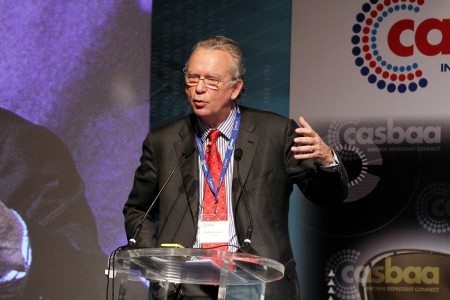
Singapore – The annual CASBAA Satellite Industry Forum concluded June 18 on a strong note as delegates agreed that growth opportunities for the sector in Asia remained emphatically positive.
Addressing nearly 250 delegates, speakers and media, Michel de Rosen, CEO & Board Member of Eutelsat, illustrated the potential of the satellite industry in Asia Pacific thanks to the region’s high population growth, incomplete terrestrial infrastructure and strong GDP prospects.
M. de Rosen added that satellite services have an assured future because of their cost-effectiveness as an unrivaled platform in terms of distribution costs per channel per home and in the ability to deliver quality TV with the bandwidth to handle HD signals – especially ultra-high definition TV. He noted that 90% of his company’s revenues in Europe are generated by video, and that Asia should be heading in the same direction.
However, Barry Matsumori, SVP, Commercial Sales & Business Development, SpaceX pointed out that with global mobile data traffic forecast to surpass 10 exabytes (1018 bytes) per month in 2016, according to a recent Cisco report, capacity will still not meet demand.
Terry Bleakley, Regional VP, Asia Pacific Sales at Intelsat acknowledged that ethnic DTH and the globalisation of Asian content are major drivers for the growth of TV in Asia while the migration from SD to HD is just one of the reasons for increased data demand.
To help solve the upcoming data crunch issue, Intelsat recently announced its “Epic” satellite solution, a high-performance, high throughput satellite combining spectrum rights in the C-, Ku- and Ka-bands to increase capacity by as much as ten-fold. Featuring switchable bands, frequency reuse benefits and backwards compatibility, Epic has been touted as “a game changer” that will ultimately lower cost per byte.
Jean-Yves Le Gall, Chairman & CEO, of launch specialists Arianespace noted the importance of creating tailor made solutions for satellite launch customers. He added that project financing through export credits and assistance with ITAR (International Traffic in Arms Regulations), Arianespace “remains creative in order to bring more to the launch service than science.”
Despite the rosy picture painted of the satellite sector in Asia, however, hurdles still exist to impede further progress.
David Hartshorn, Secretary General, Global VSAT Forum pointed out that as a result of decisions taken during the World Radio Conference 2007 in Geneva, there are now higher levels of signal interference across the Asia Pacific, with degraded end-user signal quality and potential financial losses due to spectrum grabs by terrestrial service providers.
Also of concern were the uncertain digital roll-out programmes in several markets in Asia, chief of which is India where the Ministry of Information and Broadcasting recently extended a deadline to digitise all TV homes in Chennai, Kolkata, Mumbai and New Delhi to October 31.
“While satellite services have proliferated across the region, there are still issues that remain critical,” added Twiston Davies. “These issues include the control of signal quality, access to markets and the opportunity to expand video consumption and viewership across the region. CASBAA’s role is to support its Members and industry while educating regulators and media on the significant challenges ahead for the communications business in all its forms.”








